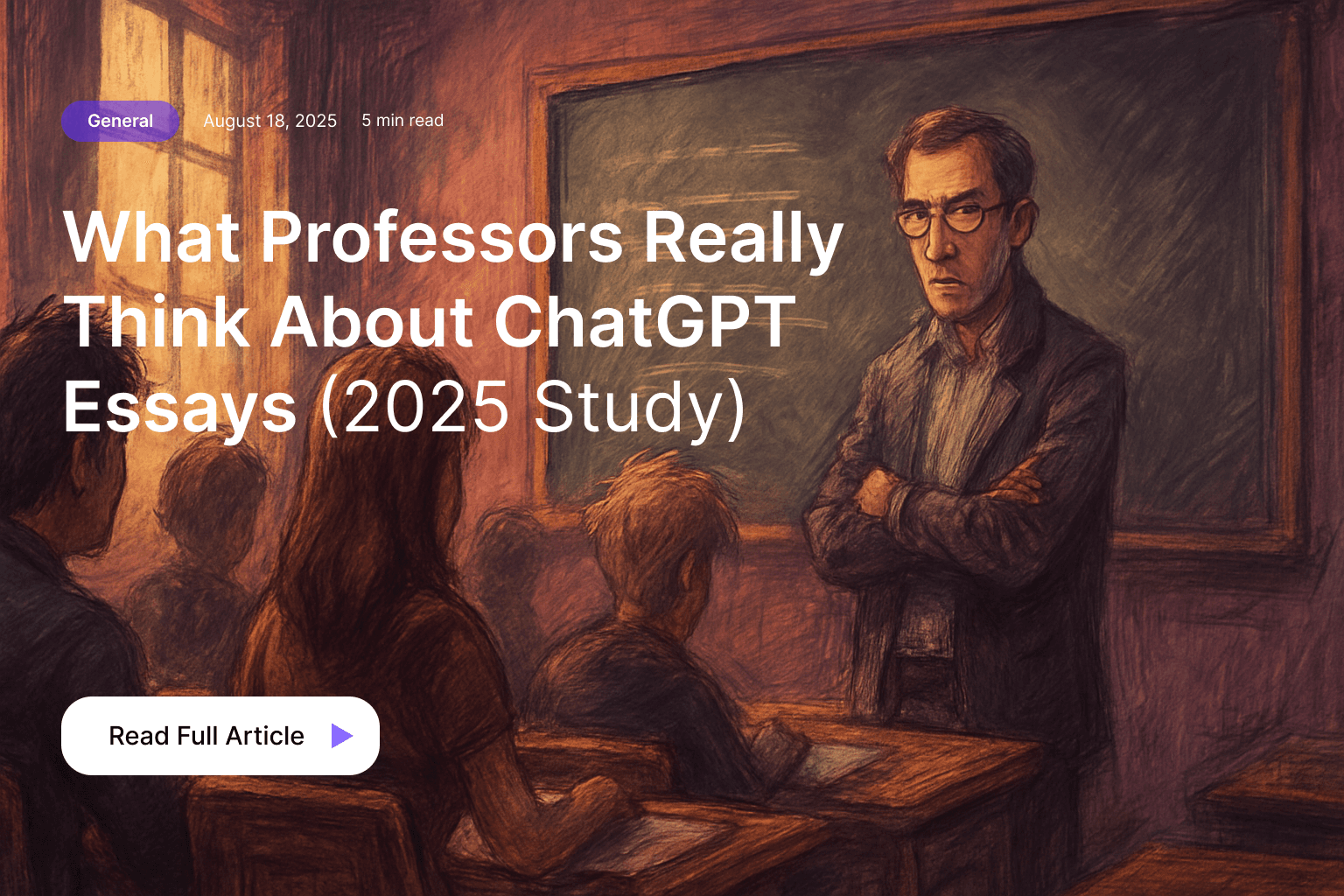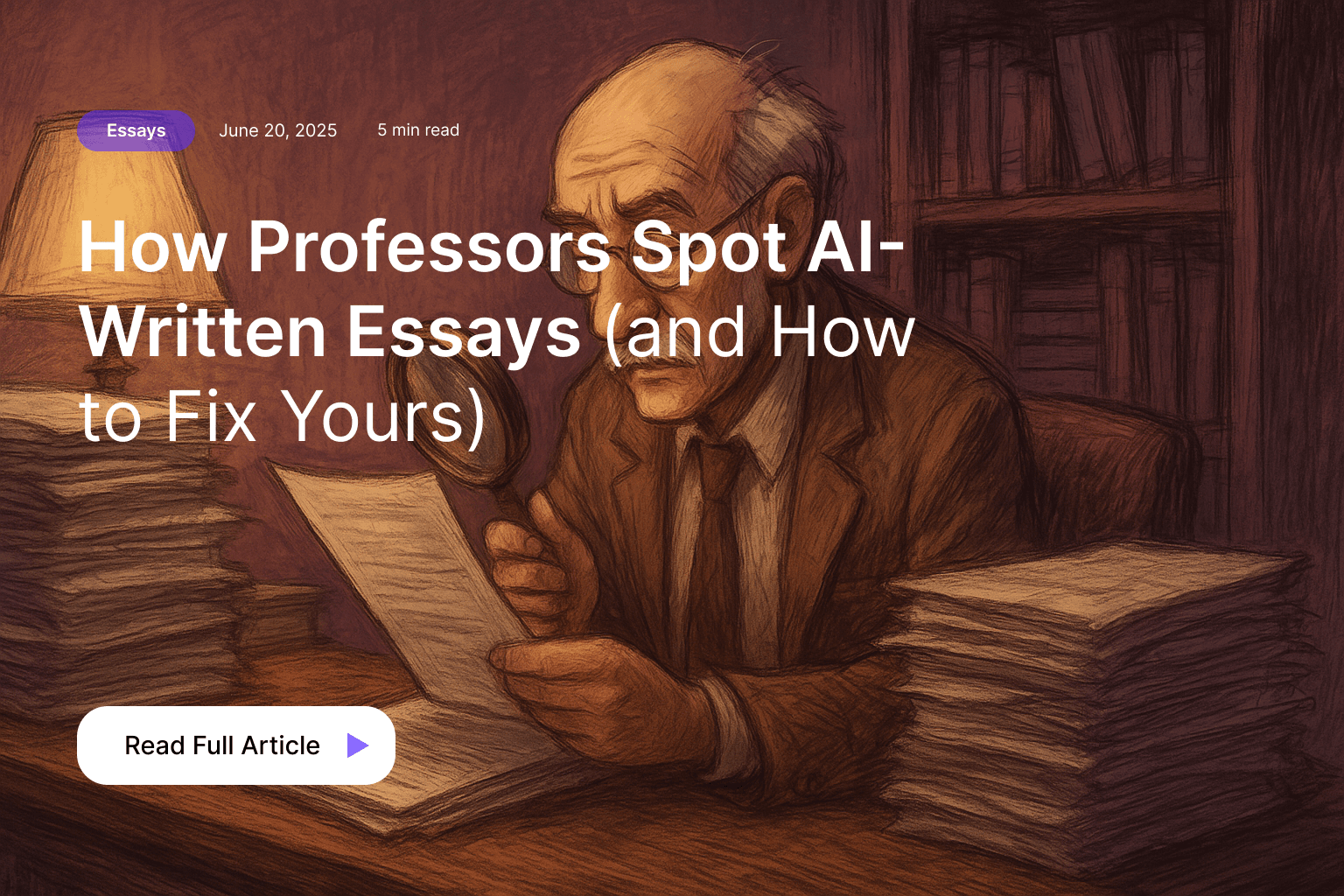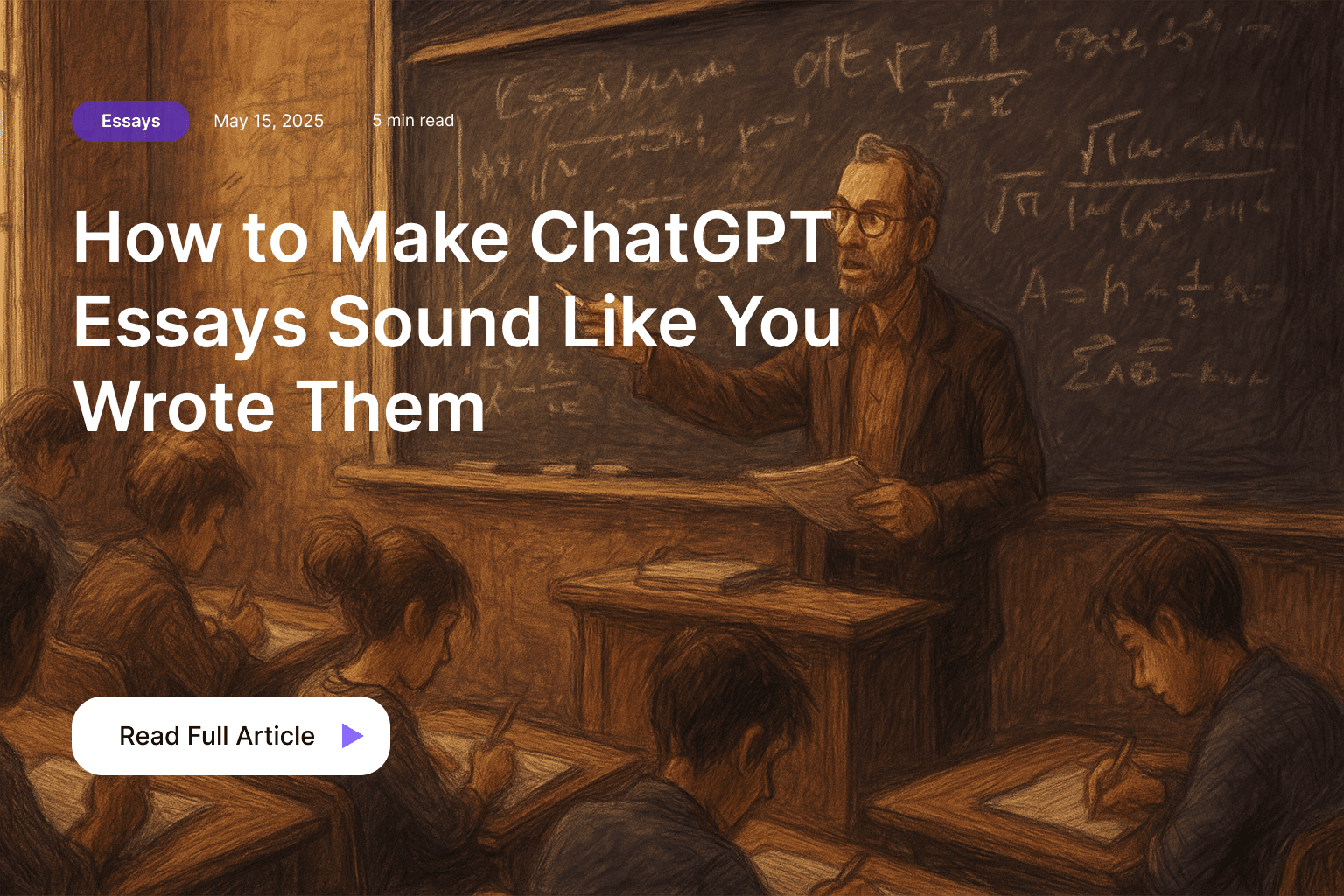When ChatGPT launched, it rewrote how classrooms function. Within months, students from Stanford to the University of Melbourne were quietly feeding prompts into chatbots, while professors scrambled to understand what it meant for academic integrity.
Two years later, the shock has faded. But the question lingers: what do professors actually think about ChatGPT essays?
The answer is more complex and more hopeful, than most headlines suggest.
1. The Great AI Divide in Academia
The academic world has always been divided when technology evolves. The same fears voiced about ChatGPT today were once said about Wikipedia, Grammarly, and even calculators.
Yet ChatGPT is different. Its outputs can imitate the rhythms of human writing, fluent, polished, confident. That power has made educators uneasy, not because of what it produces, but because of how easily it produces it.
A 2024 Inside Higher Ed faculty survey found that 61% of professors view AI tools like ChatGPT as a “potentially useful aid,” but 72% still believe students risk “eroding originality” if they rely too heavily on them.
That tension, curiosity and caution in equal measure, defines academia’s current moment.
2. What Professors Actually Say About ChatGPT Essays
The first wave of faculty reaction was alarm.
In early 2023, a Harvard writing instructor described ChatGPT’s essays as “grammatically flawless and intellectually hollow.” At Oxford, philosophy professors warned of a coming “crisis of authorship.” Meanwhile, some computer science departments quietly encouraged students to use AI to debug code, seeing it as no different from using Stack Overflow.
But by late 2024, a shift had begun. Professors stopped asking if students used ChatGPT and started asking how.
“We realized students weren’t trying to cheat,” said Dr. Amelia Cho, an English lecturer at the University of Toronto. “They were trying to sound more natural, less robotic, especially non-native English speakers. It was a language tool, not a shortcut.”
“The real challenge isn’t plagiarism,” noted another professor at King’s College London. “It’s voice. AI flattens voice. Students lose the quirks that make their writing human.”
That idea, the “flattening of voice”, appears repeatedly across interviews and editorials. It’s not that ChatGPT essays are wrong; they’re too smooth, too perfectly balanced. They lack the small imperfections that signal human thought.
3. Authenticity vs. Automation
The core concern isn’t about dishonesty; it’s about authenticity.
AI-generated essays often contain what educators call “synthetic fluency”, writing that flows but doesn’t think. Sentences look logical, but lack true argumentation. The transition words (“furthermore,” “in contrast,” “moreover”) appear on cue. Everything sounds right, until you read it twice.
For writing professors, this is the uncanny valley of academic prose.
“Students who use ChatGPT without editing it lose ownership of their ideas,” said Professor Rachel Wu of UC Berkeley. “It’s like outsourcing your voice. The grammar is there, but the soul isn’t.”
Ironically, that criticism mirrors what students say about traditional academic writing itself, that it rewards conformity over creativity. In that sense, ChatGPT has forced universities to confront something deeper: Was academic writing ever as human as we claimed?
4. How Universities Are Responding
Different institutions have taken radically different stances.
- Stanford University updated its Honor Code to explicitly allow “AI-assisted drafting” if disclosed and meaningfully revised by the student.
- The University of Cambridge prohibits AI tools in all graded submissions but encourages them in “brainstorming and planning stages.”
- Melbourne University launched workshops on “AI Literacy in Academia,” teaching both students and faculty how to evaluate and refine AI outputs.
The trend is clear: AI is moving from taboo to toolkit.
Most universities are now less interested in policing usage and more focused on how it’s integrated, with transparency, accountability, and critical thought.
5. Students’ Perspective: The Need for Clarity, Not Cheating
If you ask students why they use ChatGPT, most don’t say “to save time.”
They say:
“I wanted my writing to sound natural.”
“I’m not confident in English.”
“I use it to fix awkward phrasing.”
That pattern is especially true for international students and first-generation scholars. Many describe feeling unfairly judged for grammar and tone rather than the substance of their ideas.
So while professors worry about authenticity, students worry about being misunderstood.
That’s where the responsible use of AI tools comes in, tools that help clarify, not conceal.
“When students say they ‘use AI,’ they often mean they’re trying to make their English sound more natural, not evade effort,” one linguistics researcher observed.
This gap in perception, one side hearing “dishonesty,” the other “accessibility” - lies at the heart of the AI-in-academia debate.
6. Why AI Detectors Make the Problem Worse
In 2024, many universities adopted AI detectors to flag potential ChatGPT writing.
It backfired quickly.
False positives became common, especially for international students whose writing patterns statistically resemble AI-generated text. In one widely reported case, a graduate student at UC Irvine was accused of AI use simply because her essay had too many transition phrases.
Large-scale tests have since confirmed that AI detectors can be biased, often confusing fluency with artificiality.
“We saw essays written entirely by humans marked as 98% AI,” said a researcher from the University of Reading. “It’s not reliable enough for disciplinary use.”
That’s where the nuance matters. Detectors are trained on surface patterns, not meaning. They flag writing that’s too balanced, too predictable, the same traits teachers often rewarded before AI existed.
In response, educators are shifting toward process-based evaluation: drafts, outlines, and revisions, the human trail behind the polished prose.
7. The Role of Tools Like EssayTone
As this new landscape unfolds, a quiet middle ground is emerging.
Tools like EssayTone don’t generate essays. They refine them, re-expressing ideas with natural rhythm, variation, and clarity.
They bridge the gap between “robotic AI writing” and genuine academic voice.
Rather than trying to bypass AI detectors, they help students sound like themselves.
A student might paste in an AI-drafted paragraph that reads:
“Moreover, technological advancements have significantly transformed modern education.”
After humanization, it becomes:
“Technology has quietly reshaped how we learn, from how we write essays to how we collaborate.”
The meaning remains, but the tone feels human, conversational, and grounded.
For researchers, the same process helps translate dense writing into approachable language for publication or presentation, without compromising rigor.
In that sense, tools like EssayTone don’t compete with academia’s values; they protect them.
8. Reframing Academic Integrity
Many professors now admit that the definition of “academic integrity” itself must evolve. If writing tools can suggest phrasing or reorder sentences, where does authorship begin and end?
Historically, style guides evolved to manage similar disruptions. When word processors introduced spell-check, some academics feared it would “degrade student attention to language.” It didn’t. Instead, it raised the baseline, freeing writers to focus on argument, not mechanics.
The same may happen with AI. Properly guided, it can elevate thinking rather than replace it.
“The danger isn’t AI itself,” says Professor Cho. “It’s passivity. The moment we stop editing, questioning, or owning our ideas, that’s when education loses meaning.”
9. The Future is AI Literacy as the New Academic Skill
The conversation is shifting from “ban or allow” to “teach how.”
AI literacy — understanding how to prompt, evaluate, and edit machine output, is quickly becoming an expected skill, like citation management or data analysis.
In 2025, several universities are piloting “AI-Writing Labs” where students learn to collaborate with tools ethically: outlining first by hand, generating drafts responsibly, and refining tone with contextual tools.
Future employers will expect this too. Clear, adaptive writing shaped by human judgment and AI efficiency, is already becoming the new standard in research communication and industry reports alike.
10. A Shared Responsibility
AI didn’t eliminate the need for writing skills; it exposed how fragile our understanding of them was.
Students must learn to take ownership of their voice. Professors must learn to evaluate process, not just prose.
And tools like EssayTone must continue to design ethically — focusing on clarity, fairness, and transparency.
The ultimate goal is not to hide AI’s involvement, but to normalize responsible collaboration with it.
In a few years, academic honesty may not mean “never use AI.” It will mean:
“Use it well. Use it wisely. Use it to express your thinking, not erase it.”




